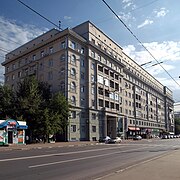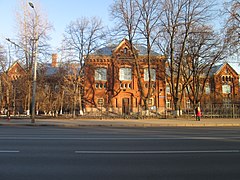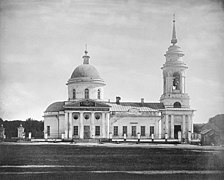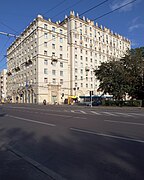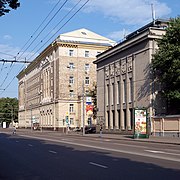Great Pirogovskaya Street
The Great Pirogowskaja Street ( Russian Большая Пироговская улица) until 1924 Large Zarizynskaja Street is a street in the district Khamovniki in central administrative district of Moscow . It leads from Subovskaya Street to the Novodevichy Convent Square . The length is 1.75 kilometers.
history
Great Pirogovskaya Street was built in the 16th century as a route from the Moscow Kremlin to the Novodevichy Monastery. This route lay on the extensive Frauenfeld (Russian Девичье поле ). The street got its first name after Peter I's first wife , Evdokija Fyodorovna Lopuchina, who lived there . In 1924 the street was renamed Big Pirogovskaya Street - in memory of Nikolai Pirogov (since the parallel Small Tsaritsynskaya Street was also renamed Little Pirogovskaya ). Today's street scene dates from the late 19th century, when the Moscow Magistrate designated an area of 18 hectares on Frauenfeld for the construction of a "medical area" in 1885. The construction of several different buildings of today's Moscow State University (MGU) began . From 1912 to 1913 an extensive green area was laid out on the Frauenfeld.
description
On the side with the odd house numbers are among others:
- the building of the medical and biological faculty Pirogov-RGMU (N ° 9, architect was A. Ostrogradski in 1909),
- the embassy of Vietnam (architect was IA Ivanov-Schitz from 1892–1894 ),
- the building of the wine warehouse N ° 3 from 1899 (after the October Revolution as the "Elektrostrahl" company, now the "Strahl" restaurant),
- the Russian State Archives of Old Files (1886),
- the Clinic for Childhood Diseases of the Setschenow Medical University (N ° 19/1, architect was KM Bykowski in 1896),
- the head office of trade of the Ministry of Defense (N ° 23, architect was I. Golossow from 1934–1938 ),
- a residential building in the style of socialist classicism from the 1930s to 1950s.
The page with the even house numbers (building from the 1880s to 1890s, architect Bykowski) belongs entirely to the Setschenow University. The Frauenfeld city park is in the first half.
In the street there were monuments to: NI Pirogow (1887); NA Semashko (1982), IM Setschenow (1958), NF Filatow (1960), FF Erisman (1937), MA Bulgakow (2018), and, from 1972, for the Medical Heroes of the Great Patriotic War. In the park there is also a memorial to the pilots of the long-distance air forces (2014) .
Demolished buildings
- Seven Councils Church . The church was built between 1813 and 1833 in place of a wooden church that burned down during the French invasion in 1812. Under Soviet rule, the church was closed for services and demolished in 1935. In the early 1950s, a residential building (number 53/55) was built on its site.
- Olga Keljina Kindergarten. The Art Nouveau building was constructed by A. Selenko and I. Kondakov from 1910 to 1911. In 1955 it was almost completely rebuilt. Now there is a Department of Defense polyclinic (house number 15).
Web links
Individual evidence
- ↑ The Frauenfeld
- ↑ The monument to Bulgakov
- ^ Church of the Seven Councils
- ↑ It is a Moscow general city kindergarten in memory of Ms. Olga Nikolaevna Keljina
Coordinates: 55 ° 43 ′ 34.7 " N , 37 ° 37 ′ 34.7" E


